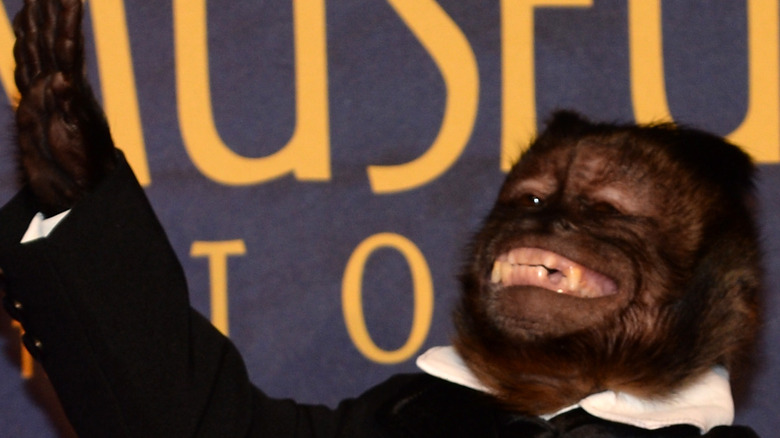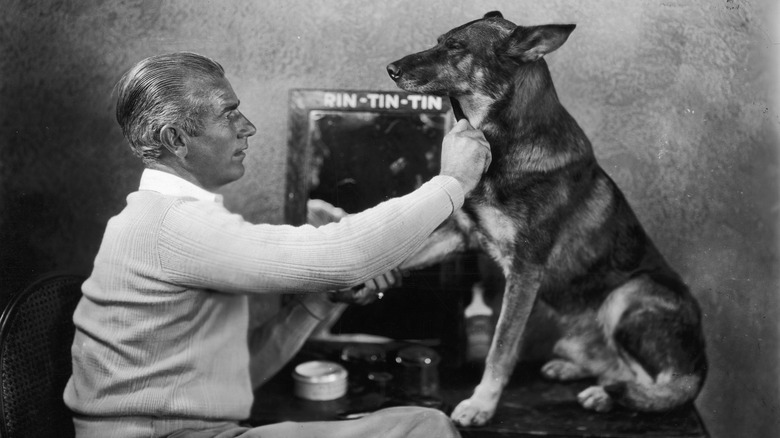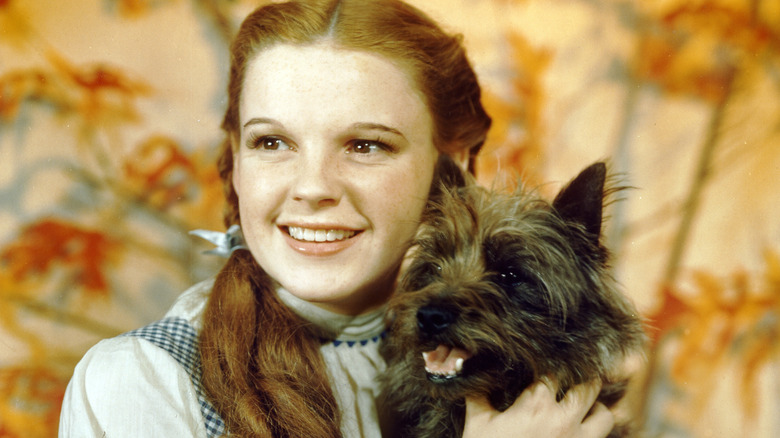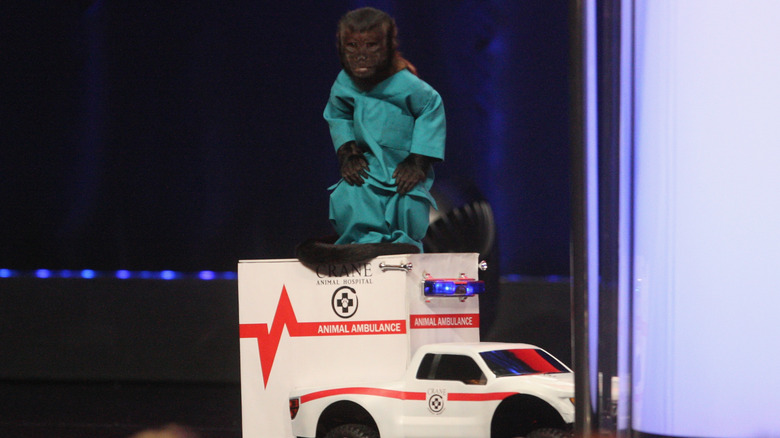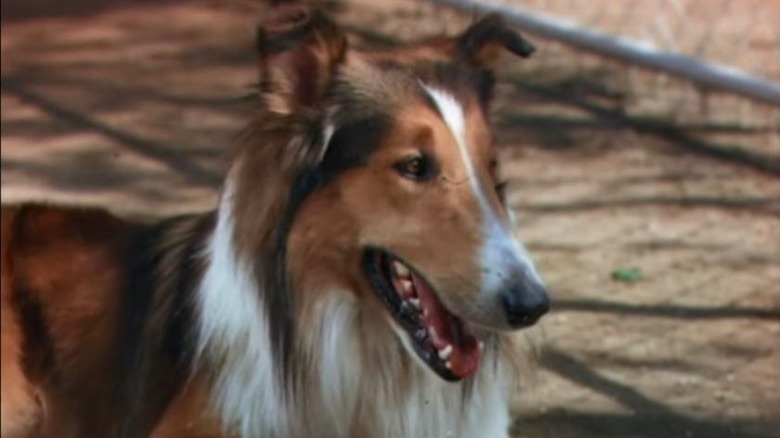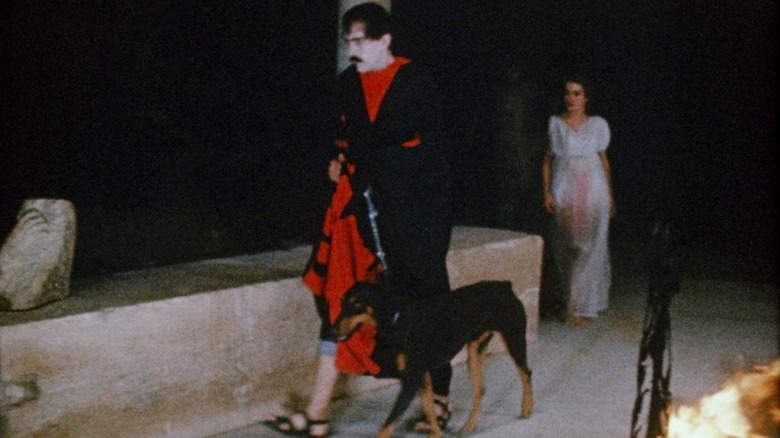Animals That Got Paid More Than The Actors
What, you thought animals worked for free? Nope, you've got to pay all your actors — even the ones who can't qualify for a credit card.
As recently as 2014 (per The Hollywood Reporter), dogs and cats were paid $400 per day, with most animal actors earning between $5,000 to $10,000 annually. It's not all that much when you consider the endless hours of training they endure to simply make it onto a set — and that average will likely remain static until dogs figure out how to unionize. But there are animal actors who command even more than that, especially highly-trained or exotic ones needed for big or long-term projects.
The salary an animal gets for any particular project is frequently difficult to ascertain, but here's a startling fact: animal actors, on occasion, get paid more than human actors. If you want to argue about why a dog would need so much cash on hand, that's a point you could debate with their handlers. But either way, let's take a look at the dogs and monkeys, if not lions and tigers and bears (oh my!), who earned more than human beings working on the same project.
Rin Tin Tin, one of the biggest earners in early Hollywood, was paid more than a co-star
Rin Tin Tin has to be one of the most legendary actors in Hollywood history. After all, how many other animals could open a film on name recognition alone? How many others got paid on their own salary, in addition to what their handler was paid? How many can claim that they took home a bigger paycheck than actual movie stars?
Journalist Susan Orlean (yes, the same one from "Adaptation") has done more research on Rin Tin Tin than almost anyone, writing the dog's biography, "Rin Tin Tin: The Life and the Legend." She also wrote an article about Rinty for the The New Yorker, where she stated that Warner Bros. paid Rinty — known as "the mortgage lifter" for his ability to make any movie he was in bankable — $2,000 per week. She also told the New York Post that the studio paid the dog eight times as much as they paid human actors.
The biography (via The Guardian) confirms at least one instance in which Rinty was paid more than his co-star. Rinty starred alongside William Collier Jr. in the 1924 Warner Bros. flick "The Lighthouse by the Sea." Rin Tin Tin was paid $1,000 a week for the role, while Collier only got $150 per week. Collier was an important enough actor to get a star on the Hollywood Walk Of Fame, and he still pulled in less of a paycheck than a dog. Though it's near impossible to locate contract information for most of Rin Tin Tin's movies, all of this info implies that Rinty getting a bigger paycheck than his co-stars was a frequent occurrence.
The dog who played Toto was paid more than the Munchkins
One of the longest persisting rumors about "The Wizard of Oz" surrounds Toto — specifically, that the dog got paid more than Judy Garland. This rumor is false. Most sources indicate that Terry, the dog who played Toto, was paid $125 a week. Garland's salary is often listed as $500 per week, certainly more than Terry, but paltry when compared to the $3k Jack Haley (The Tin Man) and Ray Bolger (The Scarecrow) received each week.
Terry, however, was paid more per week than at least 124 actors in the movie — more specifically, the dog was paid more than the Munchkins.
"The Munchkins of Oz," a 1996 book by "Oz" historian Stephen Cox, claims that the Munchkin actors each made $50 per week. Obituaries for Munchkin actors Karl Slover and Jerry Maren both repeat that $50 claim. That said, there's reason to believe the number was technically higher, if not by the time it reached their bank accounts: several sources (including a 1997 LA Times interview with Maren) indicate the Munchkins were paid $100 a week but their manager Leo Singer pocketed half of it. But whether you want to count that as $50 or $100, a dog still pulled a bigger paycheck than 124 human beings.
Crystal the Monkey makes more than the average actor
Crystal the Monkey is one of the most prominent animal actors in modern Hollywood. The capuchin's filmography is enough to make many human actors ask if she'd share the contact information for her agent. Crystal got her start in 1997, playing — what else — a baby monkey in "George of the Jungle." She has since gone on to have many prominent, recognizable roles: the drunk money in "Dr. Dolittle 2", the drug dealing monkey in "The Hangover Part II," Dexter in the "Night at the Museum" series, and a recurring role as Annie's Boobs on "Community."
Being such a prominent actor commands a big salary, even for an animal. On at least one occasion, Crystal got paid more than her human co-stars.
In 2012, Crystal co-starred in the short-lived NBC sitcom "Animal Practice." Crystal was a big part of the show's marketing and ad push, far from just some no-name animal. Just before the show debuted, TV Guide released their annual list of the highest-paid TV stars. The fifth highest paid actor for a comedy series was Crystal, pulling in $12,000 per episode. The only performers paid more than here were Hollywood elite, stars of hit shows like "Two and a Half Men" and "Modern Family" — meaning that Crystal's veteran co-stars like Justin Kirk, Bobby Lee, and Joanna García Swisher were paid less than a capuchin monkey.
In 2014, The Hollywood Reporter said that Crystal got $108,000 for her nine episodes of "Animal Practice," more than double the $52,000 SAG-AFTRA cites as the industry average a human would receive. As such, there's a decent chance that Crystal has gotten paid more than at least a few co-stars on several occasions.
Pal got paid more to play Lassie than a future megastar
1943's "Lassie Come Home" was the first movie in the legendary Lassie series, which kicked off a long-running franchise about the lovable collie. Lassie was portrayed by a (male) canine actor named Pal in "Lassie Come Home," and Pal would go on to play Lassie for years to come. Since Pal was the star of the movie, he was — despite being a dog — financially compensated for his time. While it's hard to find reliable sources on how much he got paid, it is known that he was paid more than at least one actor — one who'd go on to become kind of a big deal.
Multiple sources, including CBS News and the American Kennel Club, claim that Pal got paid more than a little girl by the name of Elizabeth Taylor. Yes, that Elizabeth Taylor. CBS News in particular claims that Pal's salary was twice that of Taylor. Granted, this was very early in Taylor's career — it was one of her first ever movies, and it wasn't exactly a meaty role — but it's still shocking that a canine actor would get paid more than a human actress, much less one who'd become one of the biggest movie stars of all time.
The Doberman from Manos: The Hands of Fate was one of only two actors to get paid
For many, 1966's "Manos: The Hands of Fate" is the stock answer for "worst movie ever made." The backstory is more compelling than the movie itself: El Paso fertilizer salesman Harold P. Warren wrote, produced, directed and acted in "Manos" after betting that anyone could make a film. He assembled a cast, shot the movie in eight days, and the end result was disastrous enough that the movie fell into obscurity. It wasn't until "Mystery Science Theater 3000" stumbled upon a copy decades later that the rest of the world learned the true horror of "Manos" wasn't creepy cults, but bad editing.
The movie was made on a reported $19,000 budget, and as such almost no one was compensated — almost.
Jackey Neyman Jones, who played Debbie, revealed to Cracked in 2016 that she and her dog (a Doberman who played the Master's familiar) were the only two actors compensated. "My dog got a 50-pound bag of food," she said. "And I got a red bike with training wheels and plastic streamers." Everyone else was promised a cut of the film's profits, which ended up being a whopping zero dollars. "Manos" fell into the public domain sometime between its premiere and its discovery by "MST3K," so that number will remain at zero. But hey, at least the dog was fed.
